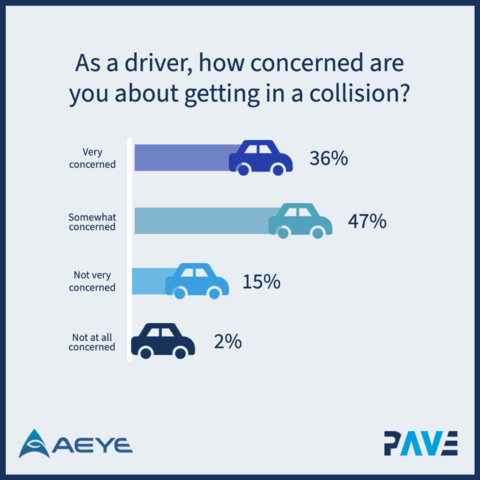The Safer Mobility Survey, conducted by PAVE and AEye, finds 82% of respondents feel safer with Advanced Driver Assistance System (ADAS) features in vehicles
More than half of respondents want improvements in pedestrian and crosswalk safety in their city or town
According to recent survey data, 83% of drivers and 78% of pedestrians are concerned about being involved in a vehicle collision, but respondents believe that new technologies can significantly improve road safety. The results of the Safer Mobility Survey, conducted by PAVE (Partners for Automated Vehicle Education) and AEye, Inc. (NASDAQ: LIDR), a global leader in adaptive, high-performance lidar solutions, were released today at CES.
This press release features multimedia. View the full release here: https://www.businesswire.com/news/home/20230105005038/en/

(Graphic: Business Wire)
The survey indicates that safer mobility needs to be a higher priority for communities nationwide. More than 40% of survey respondents chose improving safety on roads and highways as the most important transportation issue - over improving commutes and making transportation more sustainable. Annual vehicle collision fatalities are at a 16-year high, with more than 42,000 in 2021. Pedestrian fatalities also rose by 11.5%, to more than 7,485, last year, and bicyclist fatalities rose 9% from 2019 to 2020. The survey results suggest that most respondents believe road safety technologies can be the key to improving driver, pedestrian, and bicyclist safety.
PAVE and AEye fielded the Safer Mobility Survey in November 2022 to gauge Americans’ views on road safety for all road users, including drivers, pedestrians, and bicyclists. The survey of 1,095 adults found that 78% believe technology is very or somewhat important in solving driving safety issues, and 82% feel safer with technology-driven Advanced Driver Assistance Systems (ADAS) in vehicles. Blind spot monitoring was selected as the most important ADAS feature among respondents, followed by forward collision and object detection warnings. According to research by the Insurance Institute for Highway Safety, blind spot detection has helped reduce lane change crashes by 14%.
“We wanted a better understanding of what’s most important and worrisome not only to drivers, but to cyclists and pedestrians,” says Matt Bretoi, AEye’s senior director of ITS and smart cities. “The results clearly showed that pedestrians and bicyclists have heightened concerns about crossing streets safely and being struck by a vehicle, and that they want their cities and towns to do more to protect them on the road.”
Almost 58% of respondents selected improving pedestrian and crosswalk safety as their highest priority, with nearly 50% - three times more than any other category - identifying distracted drivers as their number one road safety concern. Only 13% of respondents said their city or town was doing enough to address pedestrian and bicyclist safety.
“Road safety technologies can significantly decrease crashes and highway fatalities, but these technologies can only help if drivers actually use them,” said Tara Andringa, executive director of PAVE. “The survey found that people see the safety value of new technologies, which is good news. It’s now our job to educate drivers about these technologies so we can realize their full potential.”
Investments in smart infrastructure technology for intersections, combined with ADAS or autonomous vehicle technology, provide a solution for improved roadway safety. Lidar sensors in vehicles and at intersections deliver high resolution 3D data and detection that helps identify pedestrians, objects, and other vehicles in all weather and lighting conditions. By providing high performance detection in demanding safety applications, lidar helps to improve traffic flow, protect vulnerable road users such as pedestrians and bicyclists, and ensure safe vehicle navigation.
PAVE and AEye spokespeople are available at CES, from January 5 - 8, 2023, for interviews to discuss the Safer Mobility Survey results and how technology can improve road safety for all. For the complete survey results, analysis, and graphics, please visit: Safer Mobility Survey.
About AEye
AEye’s unique software-defined lidar solution enables advanced driver-assistance, vehicle autonomy, smart infrastructure, logistics, and off-highway applications that save lives and propel the future of transportation and mobility. AEye’s 4Sight™ Intelligent Sensing Platform, with its adaptive sensor-based operating system, focuses on what matters most: delivering faster, more accurate, and reliable information. AEye’s 4Sight™ products, built on this platform, are ideal for dynamic applications which require precise measurement imaging to ensure safety and performance. AEye has a global presence through its offices in Germany, Japan, Korea, and the United States.
About PAVE
PAVE is a coalition of industry partners and nonprofit groups with one goal: To bring the conversation about automated vehicles (AVs) to the public so everyone can play a role in shaping our transportation future. PAVE’s mission is purely educational—we don’t advocate for a particular technology or specific public policies. Our members believe that we will best achieve the potential benefits of driverless technology if the public and policymakers know the honest facts of what is on the roads today and what is possible for the future.
FORWARD LOOKING STATEMENT
Certain statements included in this press release that are not historical facts are forward-looking statements within the meaning of the federal securities laws, including the safe harbor provisions under the United States Private Securities Litigation Reform Act of 1995. Forward-looking statements are sometimes accompanied by words such as “believe,” “continue,” “project,” “expect,” “anticipate,” “estimate,” “intend,” “strategy,” “future,” “opportunity,” “predict,” “plan,” “may,” “should,” “will,” “would,” “potential,” “seem,” “seek,” “outlook,” and similar expressions that predict or indicate future events or trends, or that are not statements of historical matters. Forward-looking statements are predictions, projections, and other statements about future events that are based on current expectations and assumptions and, as a result, are subject to risks and uncertainties. Forward looking statements included in this press release include statements about AEye’s lidar platform in general, the results of the Safer Mobility Survey, and benefits of road safety technologies, among others. These statements are based on various assumptions, whether or not identified in this press release. These forward-looking statements are provided for illustrative purposes only and are not intended to serve as and must not be relied on by an investor as a guarantee, an assurance, a prediction, or a definitive statement of fact or probability. Actual events and circumstances are very difficult or impossible to predict and will differ from the assumptions. Many actual events and circumstances are beyond the control of AEye. Many factors could cause actual future events to differ from the forward-looking statements in this press release, including but not limited to: (i) the risks that the results of the Safer Mobility Survey may not accurately represent concerns held by pedestrians, bicyclists, and drivers, as the respondents to the survey may not have been completely or partially truthful, the respondents selected may not have been representative, or the questions may have not been phrased sufficiently to garner completely accurate responses, among others; (ii) the risks that road safety technologies may not decrease crashes or highway fatalities, or address road user safety to the extent anticipated, or at all; (iii) the risks that investments in smart infrastructure technology for intersections, Advanced Driver Assistance Systems, or autonomous vehicle technology, may not provide a solution for improved roadway safety to the extent anticipated, or at all; (iv) the risks that lidar sensors in vehicles and at intersections may not help identify pedestrians, objects, and other vehicles in all weather and lighting conditions to the extent anticipated, or at all; (v) the risks that lidar may not improve traffic flow, protect vulnerable road users, or ensure safe vehicle navigation to the extent anticipated, or at all; (vi) the risks that the 2023 Consumer Electronics Show (CES) may not be held as scheduled, or at all; (vii) the risks that AEye may be unable to attend CES for any reason, including related to the on-going Covid-related pandemic, or be available to discuss the Safer Mobility Survey results and how technology can improve road safety; (viii) the risks that PAVE may be unable to attend CES for any reason, including related to the on-going Covid-related pandemic, or be available to discuss the Safer Mobility Survey results and how technology can improve road safety; (ix) the risks that AEye’s products will not meet the diverse range of performance and functional requirements of AEye’s target markets and customers; (x) the risks that AEye’s products will not function as anticipated by AEye or by AEye’s target markets and customers; (xi) the risks that the size of the total available market for the use of lidar will be smaller than predicted or take longer to come to fruition than predicted; (xii) the risk that laws and regulations are adopted impacting the use of lidar that AEye is unable to comply with, in whole or in part; (xiii) the risks associated with changes in competitive and regulated industries in which AEye operates, variations in operating performance across competitors, and changes in laws and regulations affecting AEye’s business; (xiv) the risks that AEye may not continue to execute against its business plan to the extent anticipated, or at all; (xv) the risks that lidar adoption occurs slower than anticipated or fails to occur at all; (xvi) the risks that AEye may not be in a position to adequately or timely address either the near or long-term opportunities that may or may not exist in the evolving autonomous transportation industry; (xvii) the risks that AEye is unable to adequately implement business plans, forecasts, and other expectations, and identify and realize additional opportunities; and (xviii) the risks of downturns and a changing regulatory landscape in the highly competitive and evolving industry in which AEye operates. These risks and uncertainties may be amplified by the COVID-19 pandemic, including the Delta and Omicron variants, as well as future variants and subvariants, which has caused significant economic uncertainty. The foregoing list of factors is not exhaustive. You should carefully consider the foregoing factors and the other risks and uncertainties described in the “Risk Factors” section of the Quarterly Report on Form 10-Q that AEye has most recently filed with the U.S. Securities and Exchange Commission, or the SEC, and other documents filed by us or that will be filed by us from time to time with the SEC. These filings identify and address other important risks and uncertainties that could cause actual events and results to differ materially from those contained in the forward-looking statements. Forward-looking statements speak only as of the date they are made.
Readers are cautioned not to put undue reliance on forward-looking statements; AEye assumes no obligation and does not intend to update or revise these forward-looking statements, whether as a result of new information, future events, or otherwise. AEye gives no assurance that AEye will achieve any of its expectations.
View source version on businesswire.com: https://www.businesswire.com/news/home/20230105005038/en/
Contacts
Media:
Jennifer Deitsch
AEye, Inc.
jennifer@aeye.ai
925-400-4366
Andie Davis
Landis Communications Inc.
AEye@landispr.com
415-766-8355
Tara Andringa
PAVE
Tara.Andringa@pavecampaign.org
Investors:
Clyde Montevirgen
AEye, Inc.
cmontevirgen@aeye.ai
925-400-4366






